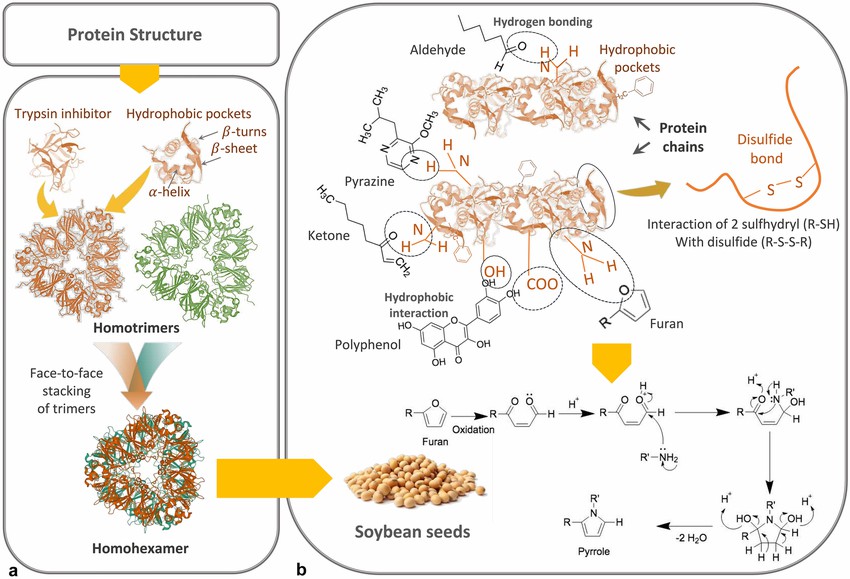Studying plant protein structure is essential for understanding plant biology, improving crop quality, and promoting agricultural production. However, the study of amino acid sequences and three-dimensional structures of plant proteins has lagged far behind that of proteins from other sources. In 1969, only six complete plant protein sequences had been established, compared to more than 230 complete plant protein sequences from other sources. By 1979, 107 complete sequences had been obtained from 28 plant proteins. Despite these sequence data, little information is available on the mechanism of action of most of these proteins, and their three-dimensional structures are needed for further studies. The main reasons why little is known about the structure of plant proteins may be due to their inherently low yields and specific difficulties in their preparation.
 Fig. 1. Structure of plant proteins (a) and interaction of off-flavors with plant proteins (b). (Saffarionpour et al., 2023)
Fig. 1. Structure of plant proteins (a) and interaction of off-flavors with plant proteins (b). (Saffarionpour et al., 2023)
In terms of the protein molecule, a protein is a peptide chain consisting of individual amino acids linked together (primary structure), the peptide chain forming a helix or fold (secondary structure), further winding to form motifs (tertiary structure), and a variety of motifs grouped in a certain pattern (quaternary structure). Lifeasible provides specialized solutions for the structural analysis of plant proteins. We aim to utilize the power of plant proteins to guide innovation in agriculture, food, pharmaceuticals, and other fields.
The primary structure of proteins is the basis for their biological function. Lifeasible offers a variety of techniques to determine the primary structure of plant proteins, mainly including the determination of the number of polypeptide chains, the type, number, and arrangement of amino acids in each polypeptide chain, and the position and number of disulfide bonds within or between polypeptide chains. Our mass spectrometry technology is widely used for protein primary structure determination, including molecular weight detection, amino acid composition analysis, peptide sequence analysis, and disulfide bond localization.
The secondary structure of plant proteins is dominated by β-folding. Lifeasible provides circular dichroism spectroscopy (CD), Fourier transform infrared spectroscopy (FTIR), nuclear magnetic resonance (NMR), and X-ray crystallography to analyze the secondary structure of plant proteins, which can provide vital information for the study of biological functions and regulatory mechanisms of plant proteins.
| Category | Description | Methods |
| Microscopy | The microscopic structure of plant proteins can be visually characterized. | Scanning electron microscope (SEM) Confocal laser scanning microscope (CLSM) Atomic force microscope (AFM) Transmission electron microscope (TEM) |
| Optical analysis | Optical analysis can provide a multi-dimensional view of plant protein structure, helping you to deeply understand plant protein conformation, interactions, and even tertiary structure changes. | Ultraviolet absorption spectrum Fluorescence spectrum Circular dichroism (CD) Fourier transform infrared spectroscopy (FTIR) Dynamic light scattering (DLS) Small-angle X-ray scattering (SAXS) |
| Cutting-edge molecular dynamics simulations | This computational approach allows us to predict protein behavior, stability, and interactions under various conditions. By simulating the motion of each atom in a protein, we can predict its behavior in various environments or when interacting with different molecules. | - |
Through an integrated experimental and computational approach, Lifeasible provides practical solutions based on cutting-edge science for the structural analysis of plant proteins. Please contact us for the best structural analysis solutions for plant proteins.
Reference